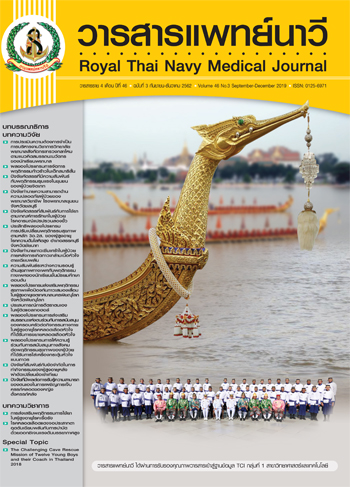Factors Predicting Patient Safety Competence of Professional Nurse in Community Hospitals, Chon Buri Province.
Main Article Content
Abstract
This predictive research aimed to examine patient safety competence of professional nurses and factors predicting patient safety competence of professional nurses in community hospitals, Chon Buri province. The sample consisted of 92 professional nurses in community hospitals, Chon Buri province. They were selected to participate in the study by using multistage sampling technique. Questionnaires were used to collect data including questionnaire of 1) personal information, 2) patient safety competence of professional nurses, 3) organizational climate, and 4) perceived empowerment. The content validity of questionnaires was reviewed by 5 experts. The reliability of questionnaires section 2, 3, 4 were 0.96, 0.96, and 0.95, respectively. Percentage, mean, standard deviation, Pearson’s product-moment correlation and multiple regressions were used to analyze data.
The research findings showed that patient safety competence of professional nurses in overall was at a high level ( = 3.98, SD = 0.48). Considering in each dimension, they also exported the high level of patient safety competence in all dimensions including contribute to 1) a culture of patient safety, 2) work in teams for patient safety, 3) respond to and disclose adverse events, 4) communicate effectively for patient safety, 5) optimize human and environmental factors and recognize, 6) manage safety risks ( = 4.10, SD = 0.46; = 4.03, SD = 0.48; = 3.96; SD = 0.49; = 3.93; SD = 0.51; = 3.93; SD = 0.55; = 3.88, SD = 0.56), respectively. Moreover, it was found that organizational climate and perceived empowerment together can significantly predict 45.7% (R2 = .457) of variance in patient safety competence of professional nurse (F(2,89) = 37.414, p < .001). However, only organizational climate was the independently predictor of patient safety competence of professional nurses (Beta = .83, p < .001).
The result of this study indicated that organizational climate is a factor influencing patient safety competence of professional nurses. Therefore, nursing administrators should promote and support the organizational climate, to promote patient safety competence of professional nurses.
Article Details

This work is licensed under a Creative Commons Attribution-NonCommercial-NoDerivatives 4.0 International License.
References
Chaleoykitti S. Patient safety and quality of nursing service. Journal of the Royal Thai Army Nurse 2014;15(2):66-70. (in Thai).
Jirapaet V, Jirapaet G. Patient safety management, concepts, procedures, and clinical safety practices. 3rd ed. Bangkok: Dansutha Karnpim Press; 2012. (in Thai).
Thailand Nursing and Midwifery Council. Nursing and midwifery outcome standard. In: Thanradee J, editors. 2rd ed. Standard of care in hospital. Bangkok: The War Veterans Organization of Thailand; 2007. p. 10-13. (in Thai).
National Health Security Office. Universal health insurance report in 2014. [Internet]. [cited 2016 October 21]. Available from: https://library2.parliament.go.th/giventake/ content_nla2557/d082058-08.
Gardlangka A. Study of medical problems and medical personnel under the Ministry Of Public Health and the Office of the Permanent Secretary for Public Health were sued for medical treatment. Journal of Department of Health Service Support 2013;9(32):57-69. (in Thai).
National Health Security Office. Annual report NHSO 2017. [Internet]. [cited 2019 September 30]. Available from: file:///D:/Documents/Downloads/131751486088225243_Annual %20Report%20NHSO%202017%20Edit%20(Compress).pdf. (in Thai).
Canadian Patient Safety Institute. The safety competencies: enhancing patient safety across the health profession 2008. [Internet]. [cited 2014 May 12]. Available from: https://www.patientsafetyinstitute.ca/en/Pages/default.aspx.
Benner P. From novice to expert: excellent and power in clinical nursing practice. California: Addison Wesley; 1984.
Stringer R. Leadership and organization climate. New Jersey: McGraw–Hill; 2002.
Kanter RM. Men and woman of the corporation. New York: Basic Book; 1993.
Faul F, Erdfelder E, Lang GA, Buchner A. G*Power 3: a flexible statistical power analysis program for the social, behavioral, and biomedical sciences. Behavior Research Methods 2007;39(2):175-91.
Nuankao P. The relationship between administrative roles of head nurses and the organizational climate according to the perception of professional nurses Southern Community Hospital. [Master’s Thesis, Faculty of Nursing]. Sukhothai Thammathirat University; 2009. (in Thai).
Bandansin J. The relationship between empowerment, teamwork, achievement motivation and work productivity of professional nurses in The Royal Thai Army Hospitals. [Master’s Thesis, Faculty of Nursing]. Sukhothai Thammathirat University; 2011. (in Thai).
Julianto R, Thiangchanya P, Boonyoung N. Nurse patient safety competencies in Aceh Province, Indonesia. Nurse Media Journal of Nursing 2014;4(1):659-70.
Jang H. Nurses’ patient safety competencies in Korea: 25th International nursing research congress 2014. [Internet]. [cited 2017 June 16]. Available from: https://Stti.confexcom/Stti/congrs14/webprogram/Paper66909.html.
Sukrearn S. Factors affecting occupational safety awareness of registered nurses in Somdech Pha Pinklao Hospital. Royal Thai Navy Medical Journal 2015;42(3):43-60. (in Thai).
Boonmee P, Makloy C. Registered nurse’s perception on patient safety culture and development of patient culture. Journal of Nursing and Education 2011;4(3):48-62. (in Thai).
Nantsupawat R, Junmahasathien S, Phumvitchuvate L, Charuwatcharapaniskul U, Chareonsanti J, Keitlertnapha P, et al. Patient safety culture and nursing outcome among professional nurses in Northern Regional Hospitals. Nursing Journal 2011;38(4):1-14. (in Thai).
Thatreenaranon S, Keyuranon P, Prasertchai A. Factor affecting patient safety culture in Somdet Chaopraya Institute of Phychiatry. The Journal of Psychiatric Nursing and Mental Health 2013;27(2):43-55. (in Thai).
The Healthcare Accreditation Institute (Public Organization). Hospital standards and health services commemoration edition celebrating Siriraj's 60th Anniversary. Nonthaburi: Deeonebook; 2011. (in Thai).
Phokapun P, Leethongdee S, Tikkapanyo C. The quality Improvement of clinical risk management system for care standard of in-patient care of nurses in the Fort Sunpasitthiprasong Hospital in Ubon Ratchathani Province. Journal of The Royal Thai Army Nurses 2012;13(2):38-48. (in Thai).
Arkasuwan M. Relationship between organizational climate and job satisfaction of professional nurses Rayong Hospitals. [Master’s Thesis, Faculty of Nursing]. Burapha University; 2011. (in Thai).
Hwang J. What are hospital nurses’ strengths and weakness in patient safety competence? Finding from three Korean hospitals. International Journal for Quality in Health Care 2015;27(3):232-8.
Porter-O’ Grady T. Introduction to evidence-base practice in nursing and health care. MA: Jones and Bartlett Publisher; 1986.
Gaff JG. Toward faculty renewal. San Francisco: Jossy Bass; 1975


